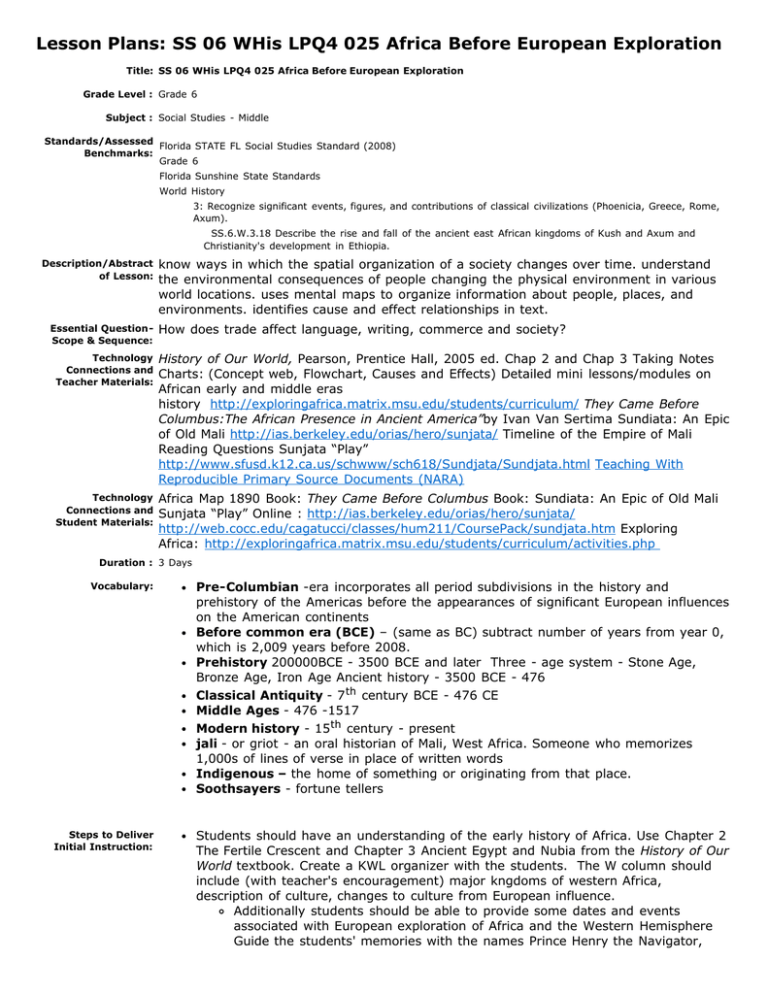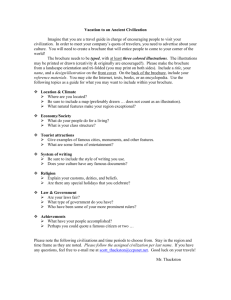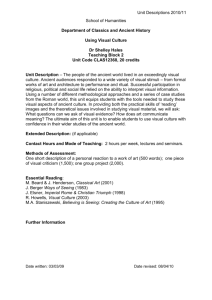Lesson Plans: SS 06 WHis LPQ4 025 Africa Before European...
advertisement

Lesson Plans: SS 06 WHis LPQ4 025 Africa Before European Exploration Title: SS 06 WHis LPQ4 025 Africa Before European Exploration Grade Level : Grade 6 Subject : Social Studies - Middle Standards/Assessed Florida STATE FL Social Studies Standard (2008) Benchmarks: Grade 6 Florida Sunshine State Standards World History 3: Recognize significant events, figures, and contributions of classical civilizations (Phoenicia, Greece, Rome, Axum). Description/Abstract of Lesson: Essential QuestionScope & Sequence: SS.6.W.3.18 Describe the rise and fall of the ancient east African kingdoms of Kush and Axum and Christianity's development in Ethiopia. know ways in which the spatial organization of a society changes over time. understand the environmental consequences of people changing the physical environment in various world locations. uses mental maps to organize information about people, places, and environments. identifies cause and effect relationships in text. How does trade affect language, writing, commerce and society? Technology Connections and Teacher Materials: History of Our World, Pearson, Prentice Hall, 2005 ed. Chap 2 and Chap 3 Taking Notes Charts: (Concept web, Flowchart, Causes and Effects) Detailed mini lessons/modules on African early and middle eras history http://exploringafrica.matrix.msu.edu/students/curriculum/ They Came Before Columbus:The African Presence in Ancient America”by Ivan Van Sertima Sundiata: An Epic of Old Mali http://ias.berkeley.edu/orias/hero/sunjata/ Timeline of the Empire of Mali Reading Questions Sunjata “Play” http://www.sfusd.k12.ca.us/schwww/sch618/Sundjata/Sundjata.html Teaching With Reproducible Primary Source Documents (NARA) Technology Connections and Student Materials: Africa Map 1890 Book: They Came Before Columbus Book: Sundiata: An Epic of Old Mali Sunjata “Play” Online : http://ias.berkeley.edu/orias/hero/sunjata/ http://web.cocc.edu/cagatucci/classes/hum211/CoursePack/sundjata.htm Exploring Africa: http://exploringafrica.matrix.msu.edu/students/curriculum/activities.php Duration : 3 Days Vocabulary: Pre-Columbian -era incorporates all period subdivisions in the history and prehistory of the Americas before the appearances of significant European influences on the American continents Before common era (BCE) – (same as BC) subtract number of years from year 0, which is 2,009 years before 2008. Prehistory 200000BCE - 3500 BCE and later Three - age system - Stone Age, Bronze Age, Iron Age Ancient history - 3500 BCE - 476 Classical Antiquity - 7 th century BCE - 476 CE Middle Ages - 476 -1517 Modern history - 15 th century - present jali - or griot - an oral historian of Mali, West Africa. Someone who memorizes 1,000s of lines of verse in place of written words Indigenous – the home of something or originating from that place. Soothsayers - fortune tellers Steps to Deliver Initial Instruction: Students should have an understanding of the early history of Africa. Use Chapter 2 The Fertile Crescent and Chapter 3 Ancient Egypt and Nubia from the History of Our World textbook. Create a KWL organizer with the students. The W column should include (with teacher's encouragement) major kngdoms of western Africa, description of culture, changes to culture from European influence. Additionally students should be able to provide some dates and events associated with European exploration of Africa and the Western Hemisphere Guide the students' memories with the names Prince Henry the Navigator, Christopher Columbus, etc. Finally students should be aware of the European's use of Africans as slaves. Refer to text for explanation of differences between slavery in Africa and slavery in Americas. Student should be able to understand the differences between primary and secondary sources; how to read and analyze sources; experience using the F(or) E(xample) A(ccording) T(o) method for in-class discussion by using Accountable Talk (I agree with you but…, I disagree with you because…, I need some clarity on this…). The FEAT and Accountable Talk methods will be used to help guide the students through the share-out portion of the lesson. Guided Practice with Feedback: This lesson focuses on Ancient Africa before European invasions, Pre-Columbian. Students will learn how to read and interpret various primary and secondary sources and how to use them to draw conclusions about the issues that the authors faced during PreColumbian times. They will also draw upon their historical comprehension skills by learning how to read historical narratives imaginatively and in their proper context, view evidence of historical perspectives and draw upon visual and literary sources while studying Ancient Africa and the issues they faced later due to the African Scramble . Motivation/Pre-Assessment: Students should be told to direct their attention to the questions that are written on the front board/ overhead. They should be given tenfifteen minutes to do the following: 1) interpret both statements and 2) write a 3-5 line statement discussing whether they think the statements would be more or less true if applied today. Question #1: Pre-Columbian - Refers to the time in the Americas before the sixteenth century -- before Christopher Columbus arrived in 1492 with the first wave of European colonists / invaders. Discuss what America may have looked like to you. Question #2: Pre-Columbian trans-oceanic contacts were interactions between the Indigenous_peoples_of_the_Americas and peoples of other continents. Discuss where they may have started. Next, students should be instructed to Think-Pair-Share their answers with another student. Students should then be invited to share either their interpretation or their opinion on whether it is still applicable in today’s society around the world. Give each student a copy of the vocabulary sheet that lists the name and basic reference information about the Pre-Columbian times and The African Scramble whose work will be discussed during the lesson and the words that will be used throughout the discussion. They should be reminded to keep the sheet handy so that it can be used in during the group investigation. Independent Practice: Differentiated Instruction/Small Groups: Students assigned one of the first 8 modules http://exploringafrica.matrix.msu.edu/students/curriculum/ to read, review, and compile 2-column notes. Left column should be sub headings. Right column is supporting facts. The selection of modules could be random or directed. Inform the students that for the next two days, they will be working in groups of four, to conduct a historical investigation into the time of Pre - Columbian to determine the types of issues they dealt with and the solutions they used to solve them. They will be analyzing primary and secondary sources (if necessary, review the definitions of both) including speeches, diary entries, pictures, plays and poetry. Each team is composed of one student from separate independent practice learning modules. Each group will choose a recorder (to record the findings); a reporter (to speak out for the group); a task manager (to handle all disputes or disagreements) and a time keeper. Hand out the source packages (see teacher materials) and activity Students will use graphic organizer “Issues and Solutions” (Causes & Effects) worksheetto complete this section. They will be looking for two things to support their conclusion: Issues (Causes): What were they and why did they exist? Solutions (Effects): What were they and how were they implemented? Encourage the students to reald and review the resources carefully in order to understand and critique the sources. Next, ask students to use a primary resource evaluation form Teaching With Reproducible Primary Source Documents (NARA). They should use this as a guide to critically analyze all of the sources. Take time to go over the sheet in detail and answer any clarifying questions. SStudents have 20-30 minutes to go through each of their primary and secondary sources and do the following: Using the I&S and PROP worksheets, they should discuss all of their sources The recorder should highlight and write down the key arguments from the texts or the key inferences drawn from the photos After reviewing all materials, they should then a) decides which were the three most important issues and why, b) write the issues on a piece of chart paper and c) have their reporter prepare to present their points (and explanations) to the class. While the students are working on their historical investigation, circulate throughout the groups to make sure that they pulling out the key information from the primary and secondary sources. Review their I&S worksheet to make sure that they are reading the sources correctly. Ten minutes before their investigation period ends, tell the students to begin preparing to end their investigation. Inform the time keeper that the groups have ten minutes to review their notes, organize their packages and prepare to present to the class. Five minutes before the investigation period ends, remind them that this is a good time to review their points to determine whether their reporter is covering all of the key issues they have gathered. They should also be told to post their chart paper onto the wall. ESE/ESOL Accommodations & ESE/ESOL Strategies: ESE and ESOL students should be incorparated into all groups. These students should also be given additional guidance and assistance on completion of 2-column notes. Lesson Closure/Review: Next, the student reporter can either stand or sit near their chart paper and present their findings. Students should be encouraged to utilize the FEAT Method and Accountable Talk (see above) during their discussion. Their classmates should be encouraged to ask questions to make sure they understand the group’s talking points. When every group has presented, tell the students they have 10 minutes to do the following: Discuss whether any group made a point that would change their position, support it or strengthen it? If so, this point (stress that they can only add one point) should be added as an addendum to their findings and written on the chart paper. go back to the prediction sheet and fill in the source 8 section of the I&S worksheet. If any groups have added addendums to their chart paper, ask them to explain their group’s addendum and how it strengthens, supports or changes their position. Now, have the students go back and fill in the L (what did I learn) portion of their KWL chart and then share out what they wrote. Creator : Middle SS Content Team Date Created : January 29, 2008 Date Modified : November 03, 2011







